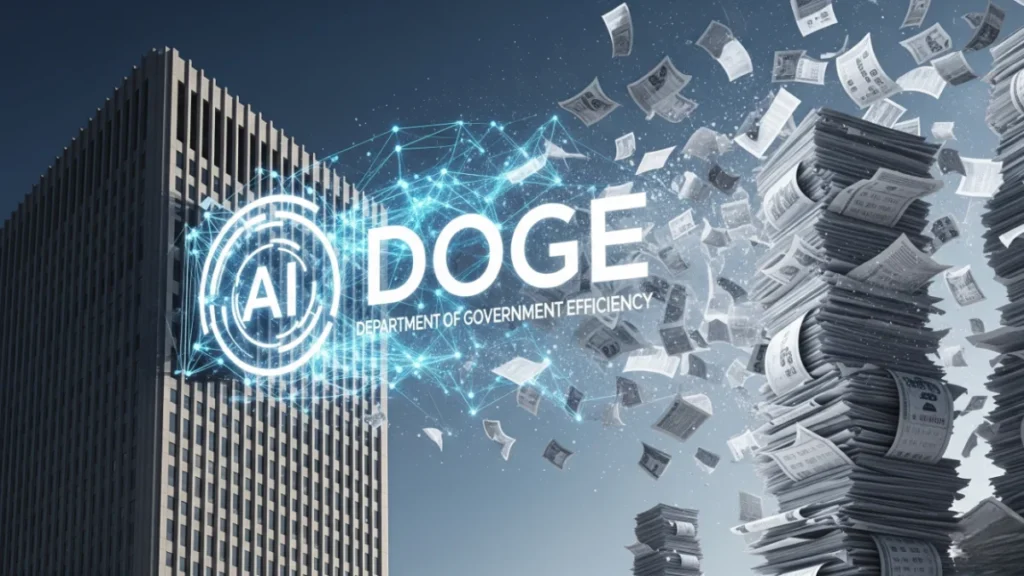The Trump-era “Department of Government Efficiency” (DOGE) is back in the headlines—this time with a bold, AI-powered plan to delete 50% of U.S. federal regulations. While the White House sees it as a revolutionary path to cut red tape, legal and ethical red flags loom large. This is how automation could change the government—and why it might not be as clean a cut as it seems.
Key Takeaways:
- AI tool built by DOGE aims to cut 100K federal regulations
- Used already at HUD and CFPB to draft mass deregulation
- Legal questions loom over accuracy and authority of the tool
- DOGE claims $3.3 trillion in potential savings—but no details
- Deadline: Trump’s team wants it all done by Jan 2026
In a bold fusion of politics and technology, the U.S. Department of Government Efficiency (DOGE)—an agency born under the Trump administration—has proposed using a proprietary artificial intelligence system to slash more than 100,000 federal regulations by early 2026.
The internal tool, dubbed the DOGE AI Deregulation Decision Tool, has already started combing through hundreds of thousands of rules, identifying those that are either outdated, redundant, or legally unnecessary. Backed by engineers from Elon Musk’s inner circle, this AI is intended to fast-track the administration’s long-running ambition to “cut the red tape” across Washington.
Documents reviewed by The Washington Post and insights from four government officials paint a picture of a government rushing to automate the legal underpinnings of modern life—from housing regulations to financial protections.
Can an Algorithm Govern Deregulation?
At its core, the AI tool analyzes more than 200,000 existing regulations. Its mission? Find the half that aren’t required by law or operational necessity—and delete them. So far, it’s made sweeping moves:
- Completed over 1,000 regulatory decisions at the Department of Housing and Urban Development (HUD) in just under two weeks
- Automated the entire deregulation output at the Consumer Financial Protection Bureau (CFPB)
That kind of speed is what DOGE claims will help agencies build full repeal lists by September 1, prepping the government for what the PowerPoint presentation calls the “Relaunch of America” on Jan. 20, 2026—the symbolic date marking the first term anniversary of Trump’s (potential) return.
The White House’s Take
White House spokesperson Harrison Fields confirmed the efforts, stating:
“All options are being explored… The DOGE experts are the best and brightest, undertaking a never-before-attempted transformation.”
However, Fields noted that no final approval has been given for the AI tool, and the initiative remains in exploratory stages.
Inside the Machine: How the Tool Works
The DOGE AI allegedly saves 93% of human labor by reviewing regulatory text, identifying statutes no longer required, and even drafting repeal language. By DOGE’s estimation, this could reclaim $3.3 trillion annually—though the exact math behind that number remains unclear.
In practice, federal staffers are shown the AI’s recommendations and asked to mark “agree,” “disagree,” or suggest stronger rollbacks. While this may sound collaborative, multiple HUD staff have raised alarms:
“There were places where the AI said the language was outside of the statute… and it was just wrong,” said one employee involved in the pilot.
A Legal Gamble?
Legal experts aren’t sold. While Trump’s previous orders—such as requiring ten rules be repealed for every new one—set the tone, this AI tool may clash with the Administrative Procedure Act, which governs how rules are repealed.
“There’s been some flashy sideshow efforts to avoid legal strictures,” said Nicholas Bagley, a law professor at the University of Michigan. “But in general, they don’t stick.”
DOGE’s own lawyers—including former Trump administration figures—have allegedly “vetted and endorsed” the tool, but their endorsement may not shield it from lawsuits or judicial review.
The Musk Connection
Interestingly, the project was partially staffed by engineers aligned with Elon Musk, according to two federal officials. Their role, while unofficial, brings a Silicon Valley-style “move fast, break things” mindset into the world of federal policy—a dangerous proposition, critics say, when regulations cover everything from clean water to financial fraud.
Speed vs. Scrutiny
Conservative circles see the AI tool as a dream scenario—finally, a way to shrink government without drowning in red tape. But for many inside government, it’s already raising red flags.
Some agencies pushed back against DOGE’s involvement, worried about outsourcing legal interpretation to an algorithm. With dwindling staff numbers and morale, the effort has also collided with practical limitations.
“The White House wants us higher on the leaderboard,” one agency source said. “But we don’t have the people to write the notices.”
So, What’s Next?
By the end of the year, nearly every major agency will reportedly receive training on how to use the AI tool. If all goes as planned, a mass culling of regulations will roll out over the next five months.
But whether it succeeds—or ends up mired in legal challenges—remains to be seen. What’s clear is this: AI is no longer just transforming tech—it’s rewriting the rules of governance itself.
